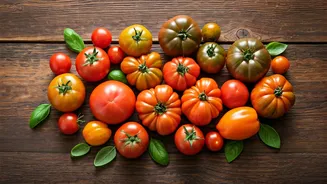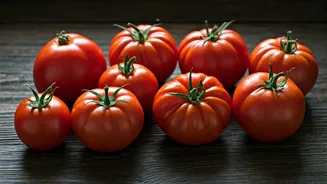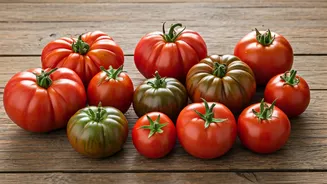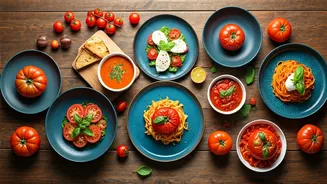Italian Pasta Perfection
Italy's contribution to tomato cuisine is substantial, with pasta sauces being a prime example. One classic is Pomodoro sauce, made simply with tomatoes,
garlic, olive oil, and basil. Another is Arrabiata, a spicy sauce with chili peppers. Then there is the rich Ragù, a slow-cooked meat sauce often featuring tomatoes. These sauces vary in consistency and complexity, but they all showcase the vibrant flavor of sun-ripened tomatoes. Each dish emphasizes the importance of fresh, high-quality ingredients, reflecting Italy's dedication to simple yet delicious food. The use of tomatoes in Italian cuisine not only enhances the taste but also symbolizes the country's rich culinary tradition.
Spanish Gazpacho's Coolness
Gazpacho, a cold soup originating from Spain, is a refreshing treat, perfect for hot weather. The base includes tomatoes, cucumbers, peppers, onions, and garlic, all blended until smooth. This soup is often seasoned with olive oil, vinegar, and sometimes bread for thickness. The preparation method can vary regionally, with some versions incorporating almonds or other ingredients. Gazpacho is not just a dish but also a cultural symbol, demonstrating Spain's ability to create delicious and healthy food, combining seasonal ingredients into a flavorful experience. It is a testament to how simple ingredients, when combined well, can produce a uniquely satisfying culinary creation.
French Ratatouille's Essence
Ratatouille, a vegetable stew from France, beautifully merges tomatoes with other summer produce. It includes tomatoes, eggplant, zucchini, bell peppers, onions, and garlic, simmered in olive oil. Each vegetable is cooked separately to achieve optimal tenderness and flavor, then combined for a harmonious result. Herbs like thyme and bay leaf add complexity. The dish's appeal lies in its simplicity and the way it celebrates the fresh flavors of the season. Ratatouille is a testament to French culinary skills, where turning simple ingredients into a gourmet experience is common. It showcases a dedication to flavors and textures, making it a beloved dish worldwide.
Mexican Salsa's Freshness
Salsa, a Mexican staple, shows the raw and vibrant side of tomatoes. Varieties are abundant, from mild to fiery, and often include tomatoes, onions, cilantro, chili peppers, and lime juice. Salsa is versatile, used as a dip, condiment, or ingredient in various dishes. The heat level is adjusted based on the type and quantity of chili peppers used. Salsa is a flavorful addition to Mexican cuisine, bringing together fresh ingredients and enhancing many meals. Its popularity across the globe speaks to its refreshing taste and adaptability, making it a beloved choice for casual dining and festive occasions. The freshness and versatility of salsa have cemented its place in culinary traditions.
Indian Tomato Curry’s Spice
Tomato-based curries are prevalent in Indian cuisine, with diverse regional variations. The base includes tomatoes, onions, ginger, garlic, and an array of spices like turmeric, cumin, coriander, and chili powder. Some versions incorporate coconut milk or cream for a richer flavor. These curries are served with rice or bread and offer various levels of spice and thickness. The use of tomatoes brings a balanced tartness to the curry. Indian tomato curries display India's culinary diversity, with a perfect blend of spices and flavors. They reflect the cultural richness and diverse cooking methods used across the nation, making them a cornerstone of Indian cuisine.
Turkish Menemen’s Warmth
Menemen, a Turkish dish, is a simple yet satisfying meal, ideal for breakfast or a light lunch. It features tomatoes, onions, peppers, and eggs, cooked together until the eggs are set. Spices like black pepper and chili flakes enhance the taste. The ingredients are gently simmered, resulting in a flavorful and hearty dish. Menemen is a beloved comfort food, showing Turkish culinary creativity. It reflects the Turkish culture, where fresh ingredients are often used in simple yet flavorful preparations. This dish is a good example of how to make a delicious and nourishing meal with simple ingredients, making it a staple in Turkish kitchens.
American Chili's Heartiness
Chili, a hearty stew from the United States, uses tomatoes as a base in many versions. It typically includes tomatoes, ground meat (or beans), onions, peppers, and a mixture of spices like chili powder, cumin, and oregano. Chili is cooked low and slow to develop flavors and is often served with toppings like cheese, sour cream, and onions. The versatility of chili enables endless variations. Chili is a symbol of American comfort food, a hearty and customizable meal. Its popularity is linked to its satisfying taste and the social value of sharing it, especially during gatherings. It showcases how food can become a cultural emblem, celebrated across different regions and traditions.
Moroccan Tagine's Depth
Tagine, a Moroccan stew, often has tomatoes as a base, combined with meat or vegetables and various spices. It is slow-cooked in a tagine pot, a conical earthenware vessel. Tomatoes, along with ingredients such as ginger, saffron, cinnamon, and dried fruits, create a complex flavor profile. The slow cooking method allows the flavors to meld. Tagines showcase Moroccan culinary artistry. They demonstrate a dedication to the flavorful and aromatic cuisine of Morocco, making it a memorable culinary experience. These dishes reflect Morocco's rich history, where food is a central aspect of cultural identity and communal life.
Japanese Tomato Ramen
Tomato ramen, a modern Japanese creation, marries Italian and Japanese flavors. It involves a tomato-based broth, often with soy sauce, dashi, and mirin. Noodles are added, along with toppings like chashu pork, soft-boiled eggs, and vegetables. The dish is customized to local preferences, which enhances the fusion flavor. Tomato ramen demonstrates the adaptability of Japanese cuisine, merging diverse culinary traditions. It reflects a willingness to innovate and embrace new ingredients, resulting in a unique and delicious dish. It showcases the global influence on Japanese cooking, leading to a fresh culinary experience.
Portuguese Açorda's Simplicity
Açorda, a traditional Portuguese soup, uses tomatoes to enhance the flavor. It involves tomatoes, garlic, olive oil, and bread, with the option of adding herbs and eggs. The bread is soaked in the flavorful broth, resulting in a rustic and filling dish. Açorda is a testament to Portuguese culinary traditions, where simplicity and fresh ingredients are valued. It reflects the culinary heritage and the resourcefulness of the Portuguese people, using basic ingredients. This soup is a heartwarming comfort food, offering a tasty and satisfying meal that is also a celebration of culinary traditions.













